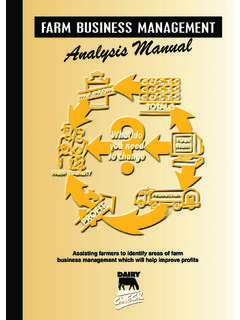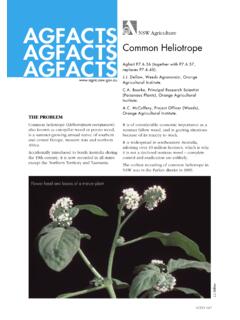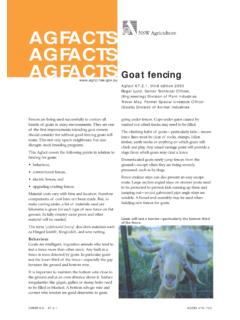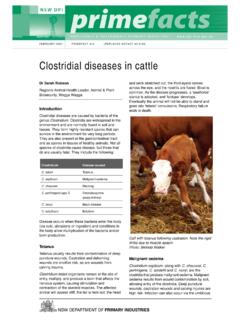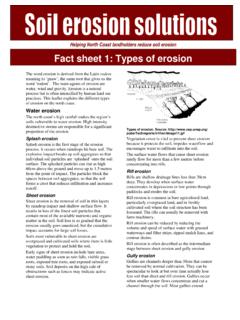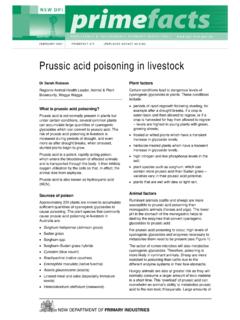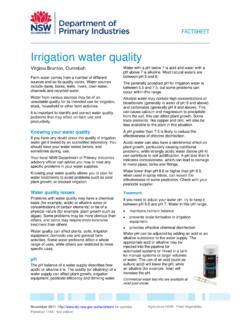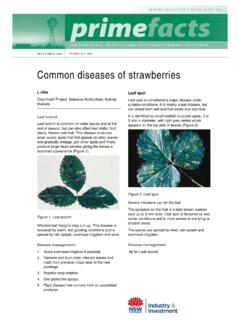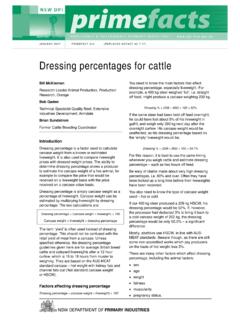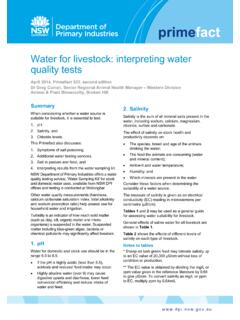Transcription of Beef stocking rates and farm size - Hunter region
1 beef stocking rates and farm size - Hunter region beef stocking rates and farm size Hunter region Authors: Ian Blackwood, DLO ( beef Products), Paterson Glenda Briggs, Agricultural Environment Officer, Paterson Jacinta Christie, District Agronomist, Scone Lloyd Davies, farm Management Economist, Paterson Neil Griffiths, District Agronomist, Paterson State of New South Wales NSW Department of Primary Industries This work is copyright. You may download, display, print and reproduce this material in an unaltered form only (retaining this notice) for your own personal use or for non-commercial use in your organisation. To copy, adapt, publish, distribute, or commercialise any of this publication you will need to seek permission from the Manager Publishing, NSW Department of Primary Industries, Orange, NSW. Published by NSW Department of Primary Industries First Published June 2006 For updates to this publication, check ISBN 0 7347 1697 4 Acknowledgements; Thanks to; Len Banks, former Director DPI Regional Relations and Education for supporting publication, Bill McKiernan, John Fisher, Wendy Goodburn, Carol & Harry Rose and Toni Laurie for reviewing the draft document and Bruce Ward for formatting.
2 Disclaimer: The information contained in this publication is based on knowledge and understanding at the time of writing (June 2006). However, because of advances in knowledge, users are reminded of the need to ensure that information on which they rely is up to date and to check the currency of the information with the appropriate officer of New South Wales Department of Primary Industries or the user s independent advisor. Job No: 6353 Contents Contents iii Introduction 4 Definitions 4 beef cattle outlook 5 Sustainable beef cattle 6 Climate 7 Rainfall 7 Temperatures 8 Soils 8 Heavy textured (basalt) soils 9 Medium to light textured soils (granite or sedimentary rock origins) 9 Alluvial soils 10 Pastures 10 Native and naturalised pastures 10 Introduced pasture species 11 Pasture carrying capacity 11 Soil P is the key 12 Common beef cattle enterprises 14 Weaner production
3 System 14 Vealer production system 15 Yearling production system 15 European Union production system 15 Feeder steer production system 16 Japanese Ox production systems (export markets) 16 Organic beef production systems 16 Gross margin budgets 17 Calculating carrying capacity and area 18 Land Use Planning Implications 22 Appendix 1: Average feed requirements 23 Appendix 2: Common native and naturalised grasses - Hunter region 24 Appendix 3.
4 Common introduced perennial grasses - Hunter region 25 Appendix 4: Land classification 28 References and further information 30 Page iii Introduction This publication seeks to help aspiring farmers in the Hunter region to identify: The important features of grazing properties and more profitable cattle enterprises, Sustainable carrying capacities, and Realistic sized properties for efficient, sustainable beef cattle enterprises, based on the concept of a function cattle unit and capacity to cover operating costs. It also provides a guide for retaining the capacity for efficient, sustainable cattle enterprises when considering the subdivision of rural grazing lands.
5 Although focused on the Hunter Valley and Gloucester areas, the methodology and background information would also apply to the wider Hunter Central Rivers CMA region and the Mid North Coast. Definitions In this publication, you will find the following terms used: DSEDry sheep equivalent (DSE) is a measure used to compare the feed requirements of different animals. 1 DSE is the average amount of pasture feed consumed by a 50kg wether (an adult but non-lactating sheep) on a monthly basis. As cattle are much bigger than sheep and need more feed, they have a higher DSE rating. DSE also depends on lifecycle, pregnancy stage and growth rate. For more information, see Appendix 1 at the end of this publication. DSE / haDSE per hectare expresses the average amount of feed available within a paddock (or property) and is useful when calculating suitable stocking rates .
6 stocking rate or Carrying CapacityThe number of cattle carried in a paddock or on a property - usually expressed as the number of cattle or breeding units per hectare. A sustainable stocking rate is one which does not degrade the natural resources or permanently reduce pasture productivity as a result of overgrazing, species loss and weed Unit (Cow & followers)A breeding unit is a cow and her offspring; that is dependant calves plus weaned cattle (followers) from the previous year, which are not yet ready for sale or use as breeders. The average (monthly) DSE requirement for a breeding unit varies for different beef enterprises in different regions because of the differing feed needs and periods over which calves are retained. Hence it is important to know the type of breeding enterprise (or DSE / breeding unit) when calculating carrying capacity, property size and future Cattle UnitA breeding herd of 40 cows was upheld in the Archibald vs.
7 Scone Council Land & Environment Court [NSW LEC proceedings No. 10180, 1987] as a reasonable and typical unit for efficient, sustainable beef cattle enterprises. Weaner, Vealer, Yearling, BullockGrowth stages of calves. Weaners are recently weaned and typically 8 9 mths old. Vealers are heavier calves of around the same age. Yearlings refer to calves around 13 15 mths old. Bullocks are larger cattle over 2 years old. Store CattleCattle requiring further fattening ( storing) before being suitable for slaughterHunter regionFor the purpose of this guideline includes the local government areas of Upper Hunter , Muswellbrook, Singleton, Cessnock, Maitland, Lake Macquarie, Newcastle, Port Stephens, Dungog, Great Lakes and Gloucester. Page 4 beef cattle outlook beef cattle are an established and dominant agricultural industry in the Hunter region (and Mid North Coast).
8 The industry defines the rural character of the region , contributes significantly to the economy and facilitates the ongoing management of rural resource lands. The Australian Bureau of Statistics 2001 survey identified that within the Hunter Central Rivers CMA region (central coast, Hunter region and Taree): Cleared pasture represents 64% of the available million hectares of agricultural land. 2,800 rural holdings or 70% of all surveyed properties held beef cattle. the estimated value of beef cattle is 9% of the statewide value. The conservatively estimated value of cattle slaughtered in 2001 was $127 million. Across much of the Hunter region the typically shallow soil depths, erodable sub soils, low soil phosphorous levels and naturally moderate to high acidity. Those soils are best suited for permanent pastures and hence grazing enterprises. Factors in favour of cattle grazing and the region s beef industry (HEDC 2003) include the: Suitability of the climate, pasture types and landscape.
9 Available service suppliers (eg, produce merchants, contractors). Proximity to infrastructure (abattoirs, saleyards, transport etc) and a range of markets. Potential for higher returns from group marketing activities. Increasing adoption of Industry standards, such as Meat Standards Australia (MSA) grading, which provide a tool for producers to identify and differentiate their products. Good international and domestic market prospects and the opportunity for professional beef producers to increase productivity and become more competitive. Most beef cattle holdings in the Hunter (and mid north coast) region , however, tend to be of relatively modest size . Contributing factors are the extended period of rural subdivision, the high cost of land and the popularity of cattle for owners of small, rural lifestyle lots. Small-scale beef enterprises (with less than 40 head of cattle) are disadvantaged by: The higher unit cost of buying relatively small quantities of items such as fertiliser, drenches, farm equipment and yards.
10 Increased costs per head for small scale pasture improvement, cattle management and mustering operations. Limited ability to negotiate prices, or to access profitable cattle markets. Reduced eligibility for taxation offsets and primary producer assistance. Limited capacity to adapt to changing market requirements, or climates, or to cover the cost of rising overheads. Higher levels of dependency on off- farm income and the associated lack of available time and focus on pastures and cattle enterprise. Stark contrast exists in the sustainability of Australian cattle enterprises linked to enterprise scale and the level of management (ABARE 2002). Whereas the top 25% of cattle producers generated an average return on investment (excluding capital appreciation), the lowest 25% had significantly smaller scale enterprises on average and generated an average loss of around $66,000/yr with a return of minus The bottom 25% of beef enterprises also had a cattle death rate twice that of the top grouping of producers, indicating poorer, less sustainable management practices.
